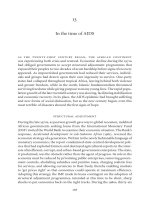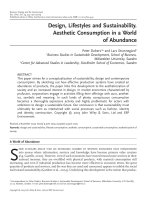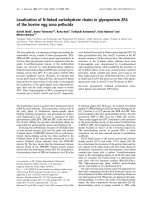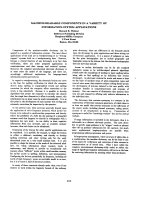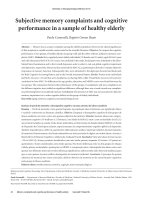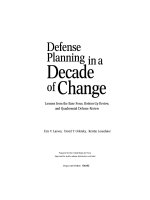Resilient supply chains in a time of uncertainty
Bạn đang xem bản rút gọn của tài liệu. Xem và tải ngay bản đầy đủ của tài liệu tại đây (389.44 KB, 15 trang )
Resilient supply chains
in a time of uncertainty
An Economist Intelligence Unit report
sponsored by Oracle
Resilient supply chains
in a time of uncertainty
Preface
Resilient supply chains in a time of uncertainty is a briefing paper created by the Economist Intelligence
Unit on behalf of Oracle. Dan Armstrong was the editor and project manager. Ronald Alsop was the writer.
Our thanks go to the senior supply chain executives and other experts who generously agreed to be
interviewed for this research.
May 2010
1
© Economist Intelligence Unit Limited 2010
Resilient supply chains
in a time of uncertainty
Contents
Preface
2
Introduction
4
Getting beyond resilience vs efficiency
4
The traditional tradeoff: Simple and compact vs complex and dispersed
5
Increasing efficiency and resilience
6
7
Rethinking supplier relationships
Supply chains: A new front in the cola war
9
9
Improving forecasts and plans
Fedex: Real-time monitoring of location, temperature and light exposure
Conclusion
2
10
11
© Economist Intelligence Unit Limited 2010
Resilient supply chains
in a time of uncertainty
Introduction
A
s companies struggle to cope with the uncertain global economy in 2010, nurturing resilient supply
chains is vital for survival. Companies must stay efficient to generate healthy cash flows, and agile
enough to jump-start production and keep customers satisfied as demand rebounds. Even if the recovery
proceeds more slowly than expected, companies cannot afford to sacrifice resilience—the ability to
recover quickly from disruptions—for the sake of efficiency.
To survive the recession, companies were forced to hoard working capital. They slashed inventories,
idled production facilities, laid off employees, negotiated more favorable deals with suppliers and
transportation providers, outsourced more supply-chain functions and found other cost efficiencies
wherever possible. They also stayed on alert for potential disruptions should key suppliers fail.
Better times now appear be ahead. Yet uncertainty still abounds. Is the level of demand sustainable?
Can suppliers stay financially healthy? Will commodity prices start to rise again? When will it become
easier to borrow from the banks?
“Sometimes it’s easier to manage on the way down in a recession than on the way up,” says Brian
Hancock, vice president of supply chain at Whirlpool Corp. “It takes quite a bit of effort to bring capacity
back on line, and everybody is hesitant to increase capacity in case they don’t see the economy returning
to 2006 and 2007 levels.”
While the companies interviewed for this report found the recession daunting, they feel as well
positioned as possible for the recovery. Rather than take a short-term approach to managing their supply
chains, they have tried to balance cost-cutting with strategic changes. These strategic objectives include:
l Ensuring sufficient resilience for a given level of efficiency. A more efficient supply chain enhances
two drivers of value: operating margin and asset efficiency. Efficiency also has the beneficial sideeffect of shrinking the carbon footprint. But none of this matters if costs are cut to the point where the
supply chain breaks.
l Strengthening relationships with suppliers. Many companies have taken steps to improve
relationships with suppliers—in some cases taking ownership stakes in them—while continuing to
police them closely for signs of financial distress and making any necessary contingency plans.
l Improving forecasts and planning. Companies are striving to improve the accuracy of demand
forecasting, to manage inventories more precisely and to better respond to customer demands.
3
© Economist Intelligence Unit Limited 2010
Resilient supply chains
in a time of uncertainty
Getting beyond resilience vs efficiency
T
he “new normal” is more than a cliché. According to an Economist Intelligence Unit survey
conducted in late 2009, most business executives believe that they now live and work in an economic
environment that is fundamentally different from the post-war business cycles of the last 65 years.1 As
the economy rebounds in fits and starts, companies realise how risky it is to focus too much on efficiency
at the expense of resilience. Even though the worst is apparently over, most executives believe that
instability and uncertainty will prevail for at least the next five years.
When demand changes suddenly, companies are often caught unawares. The leaner their supply chain,
the more jarring the changes needed to get up to speed. In its supply-chain risk survey for the third
quarter of 2009, AMR Research, a supply chain advisory service, found that 44% of respondents believed
the recovery cycle would pose the greatest risk in 2010, mainly because of possible commodity price
increases, the loss of skilled workers due to layoffs, and potential problems from inventory, capacity and
transportation constraints. At the same time, nearly one-quarter of respondents said they worry that the
downturn will continue.
Booms and busts have far-reaching effects on supply chains. When credit tightens and demand
falls, manufacturers have to cut costs—including transport costs. At the margin, supply chains shrink.
The network becomes denser. Offshoring becomes near-shoring. Events such as rising oil prices, wage
increases in China and mandated expenditures to cut carbon emissions all have the same effect: higher
costs leading to denser supply chains. FedEx’s Guadalajara warehouse expansions in 2009 were responses
to the rise in near-sourcing.
There is also a trade-off between supply chains that are simple and compact and those that are
complex, redundant and dispersed. A handful of suppliers can provide deep discounts, excellent service
and develop such a strong knowledge of processes that they become almost an extension of the company
they sell to. However, the fewer and more concentrated the suppliers, the more likely the supply chain
is to be shut down by an unforseen event. Expanding the number of suppliers may strengthen the supply
chain, but it also makes it harder to manage logistics and pricing.
1. Raising capital in a
new era, an Economist
Intelligence Unit survey
for RBC Capital Markets,
November 2009.
4
© Economist Intelligence Unit Limited 2010
Resilient supply chains
in a time of uncertainty
The traditional tradeoff: Simple and compact vs complex and dispersed
Simple/compact
More vulnerable to disruption
Less overhead
Fewer transaction costs
Complex/dispersed
Less vulnerable to disruption
More overhead
More transaction costs
More economies-of-scale potential
Harder to customise
Less economies-of-scale potential
Easier to customize
This balance between efficiency and resilience is the key tradeoff faced by supply chain managers.
But it’s not always a tradeoff; it may be possible to increase both. For instance, Whirlpool was able to
boost both efficiency and resilience by consolidating its brands and increasing the use of standardised
components.
Consolidate and simplify
Increasing efficiency and resilience
● The single-minded pursuit of efficiency leads to brittle
supply chains.
● On the other hand, the high levels of redundancy of
the most resilient supply chains make them less
efficient.
● The ideal strategy moves the curve outwards,
boosting both efficiency and resilience at each point
on the curve (for instance, from Point A to Point B).
5
Efficiency
As demand for large household appliances collapsed after the housing slump, Whirlpool Corp. closed
production facilities and furloughed workers to reduce expenses. The company also sought to become
as nimble as possible in order to react quickly to fluctuations in appliance demand. By consolidating its
many brands into warehouses centrally located within a day’s drive of one another, the company reduced
logistics costs in the North American region by 12% while cutting delivery time to customers by more than
five days.
Whirlpool is also simplifying supply chains by using standardised components in more products. That
could mean using the same electronic component or the same screw in a washer and clothes dryer. “In the
old days, 20 washers could have 20 different controls,” says Brian Hancock, vice president of supply chain
at Whirlpool Corp. “Now you might have only four different controls for 20 models.”
Consolidation and simplification are also a priority at Coca-Cola. “The recession forced us to look under
every stone and question everything we took for granted,” says Irial Finan, executive vice president of
Coca-Cola and president of bottling investments and supply chain “For example, we started questioning
B
A
Resilience
© Economist Intelligence Unit Limited 2010
Resilient supply chains
in a time of uncertainty
why trucks were coming back to the company empty. After delivering soft-drink shipments to retailers,
why couldn’t they pick up a load of cans to bring back from a nearby supplier?” The company also sees
opportunities in better planning and forecasting tools to manage the flow of products and help drive
out waste. “We’re going to end up with fewer information technology systems,” Mr Finan says, “so that a
single integrated system can tell our customers exactly where their order is, where the truck is.”
Home Depot is driving both efficiency and simplicity by moving from a direct-to-store model to central
distribution. Rather than deliver home-improvement products to individual Home Depot stores, suppliers
will send a bulk order for about 100 stores to the company’s new Rapid Deployment Centers. Merchandise
will be sorted for specific stores based on the latest sales data and delivered daily, minimising inventory
and freeing cash flow and working capital, according to Mark Holifield, Home Depot’s senior vice president
of supply chain. Central distribution also will eliminate vendor minimums, he says, meaning that store
managers will no longer have to gamble on being either stuck with excess inventory or out of stock on
specific products.
6
© Economist Intelligence Unit Limited 2010
Resilient supply chains
in a time of uncertainty
Rethinking supplier relationships
P
erhaps the greatest lesson companies learned from the recession is the value of close-knit
relationshipss with key players in their supply chains. Making vendors feel like partners leads to
greater communication, trust and loyalty. Companies interested only in cutting supply-chain costs and
boosting their own bottom lines may find themselves at the back of the line when customer demand
exceeds supplier capacity in this recovery.
“There is still a lot of greed in outsourcing,” says Kate Vitasek, author of the book Vested Outsourcing:
Five Rules That Will Transform Outsourcing. “Enlightened companies realise the long-term value of taking
a cooperative approach with their supply-chain partners to develop solutions where each is vested in the
other’s success. Supply-chain partners are integral to our business, so why would we try to outwit or fight
with our own family?”
The more essential the product supplied, the more critical it is to develop and nurture relationships
with suppliers and outsourcing partners. For highly specialised parts, companies may also want to protect
Supply chains:
A new front in the cola war
PepsiCo announced plans in August 2009 to acquire its
two major bottlers, contending that the merger would
produce more flexibility, efficiency and cost savings in
manufacturing, distribution and marketing. “The fully
integrated beverage business will enable us to bring
innovative products and packages to market faster,
streamline our manufacturing and distribution systems,
and react more quickly to changes in the marketplace,
much like we do with our food business,” Indra Nooyi,
chairman and CEO, explained.2
At the time, Coca-Cola Co. didn’t seem inclined to
make a similar acquisition. Chairman and CEO Muhtar
Kent commented that the company still believed in the
independent bottler model regardless of PepsiCo’s new
7
strategy. But Coca-Cola soon followed its rival’s lead
in February 2010, announcing that it would acquire
the North American bottling operations of Coca-Cola
Enterprises Inc.
The reasons? Efficiency, flexibility and cost savings.
“We will reconfigure our manufacturing, supply chain
and logistics operations to achieve cost reductions over
time,” Mr Kent said. “Importantly, the creation of a
unified operating system will strategically position us to
better market and distribute” the company’s beverage
brands.3
The acquisitions make sense, given changes in the
retail market and the beverage industry. Most notable
is the growth of non-carbonated beverages, which have
different distribution systems than carbonated soft
drinks and have become a much bigger part of both
Coca-Cola’s and PepsiCo’s business.
2. “PepsiCo Reaches
Merger Agreements with
Pepsi Bottling Group and
PepsiAmericas,” Pepsico
press release, August 4,
2009.
3. “The Coca-Cola
Company and Coca-Cola
Enterprises Strategically
Advance and Strengthen
Their Partnership,”
Coca-Cola press release,
February 25, 2010.
© Economist Intelligence Unit Limited 2010
Resilient supply chains
in a time of uncertainty
themselves by identifying a secondary source.
“We need to find a better way to identify sooner any potential risks with our very small, critical suppliers
that are manual intensive and specialised,” says a director of sales and operations planning at a large
IT company. “Then we have to try to protect them. We can also take on inventories so we always have a
stockpile of critical parts and consider dual sourcing.”
Some of the company’s suppliers went bankrupt during the recession, further complicating an already
complex supply chain and causing the company to miss out on potential sales. “Bankruptcies were
especially significant in the memory market,” says the director. “Some commodities suppliers have
hamstrung everyone.
Shortages and long lead times could intensify. “If demand from business customers continues to ramp
up as it has over the last nine months, and if consumer demand strengthens, the situation will get even
more interesting,” he adds. “The same guys who give us memory give Apple memory; there are a lot of
common components among companies.”
During this downturn when credit has been tight, some companies have provided financial support
to wobbly suppliers to ensure that their needs would be met short-term, as well as to show their deeper
commitment. “We try to make sure we’re doing risk sharing with our suppliers,” he says. “We identify key
suppliers and make certain that they are as robust as possible and aligned with our strategic objectives. If
we want to get more aggressive in the marketplace, we can help suppliers expand capacity if they’re not in
a strong position by buying them equipment.”
Because some suppliers may still be on shaky ground this year, companies must continue to scrutinise
their most crucial vendors. Getting an accurate reading on suppliers’ finances may not be easy, but
companies can look for signs of weakness, such as a decline in on-time delivery or product quality, and
ask to see financial statements. If suppliers refuse to provide current financial data, it’s probably time to
consider switching to another vendor or at least lining up a backup player.
Whirlpool continues to compile a “watch list” of vendors with potential financial problems. “We quickly
find out what we can do to help,” says Mr Hancock. “We also now keep some inventory of critical parts,
especially electronics, on hand because it’s such a long supply chain. In the past we might have told Mister
Supplier to keep all the inventory of little footpads on washing machines, but no longer.”
Whirlpool stays very close to its biggest suppliers in steel and electronics, and works more closely than
ever with them on production and design plans. “The most valuable thing we can do is give suppliers
the best signals possible so they keep capacity warm and make sure they are committed to Whirlpool’s
success,” says Mr Hancock. “We can’t survive without one another.”
While it’s most crucial to monitor first-tier suppliers, companies also should be scrutinising secondand third-tier vendors. “The focus cannot only be on suppliers of highly specialised or high-volume
components,” says Mr Smith of Lenovo. “Companies shouldn’t overlook the risk of losing a vendor that
makes basic yet essential parts. The loss of either could result in a significant supply chain disruption.”
A valuable strategy for collaboration and mutual survival, he says, is negotiating long-term supplier
agreements.
Some companies are slashing their supplier networks to save money, making themselves more
dependent on fewer vendors and more vulnerable should any of them falter. As part of a larger
8
© Economist Intelligence Unit Limited 2010
Resilient supply chains
in a time of uncertainty
restructuring, for instance, Sony Corp. plans to halve its number of suppliers in a bid to save money by
purchasing larger volumes of parts and materials at lower costs from the remaining vendors. Such a
major streamlining makes it critical that Sony nurture relationships with its smaller circle of vendors and
monitor their financial health to prevent supply-chain disruptions.
That’s what Whirlpool did when it eliminated some of its freight carriers during the recession. Instead
of bidding out freight to get the lowest rates, the company gave more business to the smaller group of
carriers and strengthened its connections with them. “In the midst of all this volatility in the housing
market and the retail landscape, we can’t control the banks, we can’t control the economy, but we can
control supplier relationships,” says Mr Hancock.
As part of a transformation that began in 2009 to become more operationally efficient, Lenovo decided
that “one-size-fits-all supply chain solutions no longer adequately support the needs of customers within
the complex PC marketplace,” says Gerry Smith, senior vice president of global supply chain. “Lenovo’s
response to changing market trends is a differentiated set of supply chain models capable of supporting
traditional Lenovo accounts while attracting new business from emerging market segments,” he says.
Traditional commercial customers demand a highly flexible, responsive supply chain capable of delivering
premium products and mass customisation. They are supported by Lenovo’s “build to order” offering.
Other customers—consumers, small businesses and price-sensitive emerging market customers—place a
greater premium on predictability, efficiency and low cost.
To meet the requirements for this segment, Lenovo focused on predictable deliveries of products that
are ‘built to plan.’ By tailoring the supply chain to each market, Lenovo was able to significantly improve
demand sensing and successfully respond to changing customer needs.
As the computer market improves, Lenovo still sees much work ahead to sustain its momentum. “The
lessons learned during the recession must not be forgotten as the economy improves,” says Mr Smith.
“Companies like Lenovo must remain flexible and agile, always willing to adjust operations in order to
continuously drive improvements.”
9
© Economist Intelligence Unit Limited 2010
Resilient supply chains
in a time of uncertainty
Improving forecasts and plans
A
s companies have been whipsawed by sudden shifts in demand, they have learned valuable
lessons for improving forecasting and planning. Often this requires investing in new technology.
“Information technology is playing a significant role in taking uncertainty out of the supply chain and
helping companies plan and schedule better,” says Dave Closs, chairman of the supply chain management
department at Michigan State University’s Eli Broad School of Business. “Technology also helps
companies determine trade-offs: How do I best use capacity to minimise cost and maximise profitability?
Which production facilities do I use for high-volume versus low-volume products?”
This recession is the first in which USG Corp., a US-based maker of construction materials with 2009
sales of $3.2bn, exploited its advanced planning technology. As the bubble burst in the US housing
market, the firm used its centralised planning system to cut production capacity strategically and reduce
costs. As demand plummeted for residential housing, technology tools helped USG determine the
optimal use of manufacturing plants for specific products and markets. “Now, we are looking at long-term
forecasts and running models five to 10 years into the future to help us determine when and what we
will need to bring back online first,” says Timothy McVittie, senior director of logistics for USG Building
Systems.
Even with advanced technology tools and models, USG faces the challenge of meeting customer
expectations while aggressively keeping inventory lean. It must be flexible enough to adjust capacity to
avoid product shortages. “Finding the right balance is a big hairy beast,” says Mr McVittie. “Considering
that industry demand is as low as it is, the marketplace has little patience for manufacturers who cut too
deep and can no long effectively service their customers.”
Meanwhile, Unipart Logistics, which manages the auto-parts supply chain for Jaguar Cars, has made
use of its historical demand data to better match inventory in regional distribution centers to local
demand. That means more parts and accessories for convertibles sold in California, and more snow tires
and replacement panel parts for those sold in the Northeast during winter weather.
“We realised we were holding too many parts in our distribution centers with low demand in the regions
they served,” says Richard MacLaren, Unipart’s president and general manager for North America. “Now
we have increased the availability of the right parts at the warehouse serving a particular dealer, cutting
down on emergency orders from other warehouses and express air freight deliveries from the UK.”
The large IT firm referred to earlier has developed a set of planning and analytical tools that enable
10
© Economist Intelligence Unit Limited 2010
Resilient supply chains
in a time of uncertainty
Fedex: Real-time monitoring of location,
temperature and light exposure
Today’s technologies can let supply chain managers follow a
shipment’s every move, from the production line through the
transportation network of planes, trains and trucks to the ultimate
destination. The technology is now allowing managers and customers
to verify the shipment’s condition, too.
A new Fedex service called SenseAware is designed to help life
sciences customers track sensitive items like surgery kits, tissue and
pharmaceuticals. A specialised GPS unit transmits signals customers
can track on a website. When attached to ground or air shipments,
the device sends data including precise temperature readings, when
a shipment is opened and whether the contents have been exposed
to light. SenseAware is initially targeted for the healthcare and life
sciences segment, but is expected to be generally available to all
industries 12-18 months following the launch in June 2010.
The data collected by SenseAware can be crucial for shipments
that must remain in low-light environments or within a certain
temperature range to be effective in treating patients. The
technology will also help life science customers comply with audits
and quality checks that occur regularly on highly regulated products.
Other potential applications of SenseAware include shipments of
light-sensitive film, art and antiquities, hazardous items such as
explosives and organic matter like plants and meat.
Fedex’s service is part of a larger trend called “the internet
of things.” The internet of things consists of sensors embedded
in physical objects and linked through wireless networks, often
comprised of a set of standard IP addresses. Other internet of things
applications include process automation (collecting process data
and feeding it back so the process can be modified) and monitors of
customer traffic and behaviour in stores (useful in designing store
layouts to increase sales).
Slowing this trend is a lack of standardisation among myriad
suppliers within the industry. That’s why it is important that a major
player enter the market and establish standards. Said Fedex EVP
and CIO Rob Carter: “The sensor-based logistics industry wasn’t
solidifying as quickly as we thought it should around useful sharing of
sensor information.” As a result, he said, “Sharing sensor information
dynamically and in useful ways with supply chain partners proved too
difficult, so we attacked this on a number of fronts and the result is
SenseAware.”
the company to focus on the customer orders that drive the most revenue. They have long invested in
analytics to show the tradeoffs from both an operational and financial point of view. “The devil is in the
details,” says the director. “We need to be able to zoom down and see what drives the most revenue, which
are the most critical customer orders we’re likely to get, and how we can reduce lead times.”
But the company has found that relying on multiple databases slows it down, so it is creating a data hub
for running simulations and decision-making. “We will be bringing together economic and sales forecasts,
customer orders as they come in, cost data, available supply information, and archival information from
previous years,” he says. “At the end of the day, it’s all about balancing what is acceptable to customers
and what we can afford. But we are focused on driving market share, so we’d much rather have to worry
about getting rid of excess inventories than losing sales.”
One challenge for the company is taking a more holistic view of its supply chain—from vendors through
to the end users. To try to get a clearer line of sight, the company will connect customer teams to a
planning group for suppliers. “We need to do a better job of seeing the whole picture,” says the director.
“How can we connect what a large customer wants with what a large supplier does?”
11
© Economist Intelligence Unit Limited 2010
Resilient supply chains
in a time of uncertainty
Conclusion
G
oing forward, companies will continue to strive to be as nimble as possible in order to fully capitalise
on any rebound in demand, while staying alert to continuing risks in an uncertain economy. Despite
the pickup in US growth, the pace of recovery remains unpredictable and will vary by industry. Some
companies concede that getting their supply chain in tune with the marketplace may be trickier in good
times than bad. But those companies that took a longer-term view in making their supply chains more
efficient should be agile enough to adapt to fluctuating demand in this uneven upturn.
Now is the time for companies to:
l Reassess supply chain processes to ensure that progress towards efficiency does not boost the
potential for failure in the face of economic, operational or environmental disruptions. And taking this
dictum a step further, companies should attempt to control risks better and plan for various scenarios,
given the unpredictable nature of the recovery.
l Foster mutually beneficial partnerships with key vendors to ensure reliability and reduce the odds of
supply disruptions. Full ownership of suppliers (as in the Coca-Cola case) is at one end of the spectrum;
at the other is discarding the weak links and focusing on a handful of strong and reliable partners.
l Make better use of data to meet the company’s strategic objectives. Like the large IT firm referred to in
the paper, companies should attempt to bring together demand and economic data from the past—as
well as in real time—to drive revenues, margins, market share or other goals.
12
© Economist Intelligence Unit Limited 2010
Design: Cover image: iStockphoto.com
Whilst every effort has been taken to verify the accuracy
of this information, neither The Economist Intelligence
Unit Ltd. nor the sponsors of this report can accept any
responsibility or liability for reliance by any person on
this white paper or any of the information, opinions or
conclusions set out in the white paper.
LONDON
26 Red Lion Square
London
WC1R 4HQ
United Kingdom
Tel: (44.20) 7576 8000
Fax: (44.20) 7576 8476
E-mail:
NEW YORK
750 Third Avenue
5th Floor
New York, NY 10017
United States
Tel: (1.212) 554 0600
Fax: (1.212) 586 0248
E-mail:
HONG KONG
6001, Central Plaza
18 Harbour Road
Wanchai
Hong Kong
Tel: (852) 2585 3888
Fax: (852) 2802 7638
E-mail:
GENEVA
Boulevard des Tranchées 16
1206 Geneva
Switzerland
Tel: (41) 22 566 2470
Fax: (41) 22 346 93 47
E-mail:
